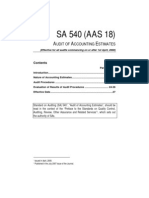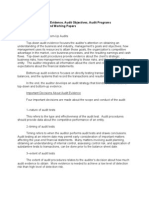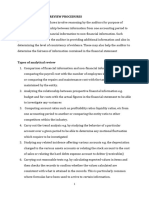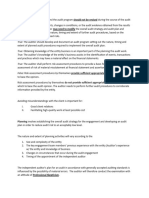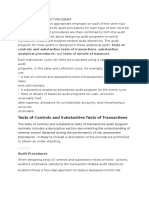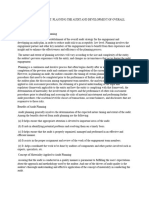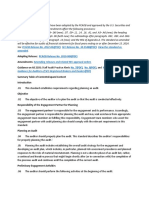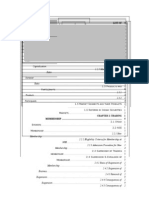SA 520 (AAS 14) : Nalytical Rocedures
SA 520 (AAS 14) : Nalytical Rocedures
Uploaded by
Sky509Copyright:
Available Formats
SA 520 (AAS 14) : Nalytical Rocedures
SA 520 (AAS 14) : Nalytical Rocedures
Uploaded by
Sky509Original Description:
Original Title
Copyright
Available Formats
Share this document
Did you find this document useful?
Is this content inappropriate?
Copyright:
Available Formats
SA 520 (AAS 14) : Nalytical Rocedures
SA 520 (AAS 14) : Nalytical Rocedures
Uploaded by
Sky509Copyright:
Available Formats
SA 520 (AAS 14)
ANALYTICAL PROCEDURES
(Effective for all audits relating to accounting periods beginning on or after April 1, 1997)
Contents
Paragraph(s) Introduction ..........................................................................................13 Nature and Purpose of Analytical Procedures .................................4-7 Analytical Procedures in Planning the Audit ....................................8-9 Analytical Procedures as Substantive Procedures ......................10-12 Analytical Procedures in the Overall Review at the End of the Audit .......................................................................... 13 Extent of Reliance on Analytical Procedures ...............................14-16 Investigating Unusual Items ...........................................................17-18 Effective Date ........................................................................................ 19
Standard on Auditing (SA) 520 *, Analytical Procedures should be read in the context of the Preface to the Standards on Quality Control, Auditing, Review, Other Assurance and Related Services1, which sets out the authority of SAs.
* 1
Issued in December, 1997. Published in the July 2007 issue of the Journal.
Handbook of Auditing Pronouncements-I
Analytical Procedures
Introduction
1. The purpose of this Standard on Auditing (SA) is to establish sta ndards on the application of analytical procedures during an audit. 2. The auditor should apply analytical procedures at the planning and overall review stages of the audit. Analytical procedures may also be applied at other stages. 3. Analytical procedures means the analysis of significant ratios and trends, including the resulting investigation of fluctuations and relationships that are inconsistent with other relevant information or which deviate from predicted amounts.
Nature and Purpose of Analytical Procedures
4. Analytical procedures include the consideration of comparisons of the entity's financial information with, for example: Comparable information for prior periods. Anticipated results of the entity, such as budgets or forecasts. Predictive estimates prepared by the auditor, such as an estimation of depreciation charge for the year. Similar industry information, such as a comparison of the entity's ratio of sales to trade debtors with industry averages, or with other entities of comparable size in the same industry. Analytical procedures also include consideration of relationships:
5.
Among elements of financial information that would be expected to conform to a predictable pattern based on the entity's experience, such as gross margin percentages. Between financial information and relevant non-financial information, such as payroll costs to number of employees. 6. Various methods may be used in performing the above procedures. These range from simple comparisons to complex analyses using advanced statistical techniques. Analytical procedures may be applied to consolidated financial statements, financial statements of components (such as subsidiaries,
SA 520 IV32032 0320 SA 520
Handbook of Auditing Pronouncements-I
Analytical Procedures
divisions or segments) and individual elements of fina ncial information. The auditor's choice of procedures, methods and level of
SA 520
IV32132 1321
SA 520
Handbook of Auditing Pronouncements-I
Analytical Procedures
application is a matter of professional judgement. 7. (a) (b) Analytical procedures are used for the following purposes: to assist the auditor in planning the nature, timing and extent of other audit procedures; as substantive procedures when their use can be more effective or efficient than tests of details in reducing detection risk for specific financial statement assertions; and as an overall review of the financial statements in the final review stage of the audit.
(c)
Analytical Procedures in Planning the Audit
8. The auditor should apply analytical procedures at the planning stage to assist in understanding the business and in identifying areas of potential risk. Application of analytical procedures may indicate aspects of the business of which the auditor was unaware and will assist in determining the nature, timing and extent of other audit procedures. 9. Analytical procedures in planning the audit use both financial and nonfinancial information, for example, the relationship between sales and square footage of selling space or volume of goods sold.
Analytical Procedures as Substantive Procedures
10. The auditor's reliance on substantive procedures to reduce detection risk relating to specific financial statement assertions may be derived from tests of details, from analytical procedures, or from a combination of both. The decision about which procedures to use to achieve a particular audit objective is based on the auditor's judgement about the expected effectiveness and efficiency of the available procedures in reducing detection risk for specific financial statement assertions. 11. The auditor will ordinarily inquire of management as to the availability and reliability of information needed to apply analytical procedures and the results of any such procedures performed by the entity. It may be efficient to
SA 520
IV32232 2322
SA 520
Handbook of Auditing Pronouncements-I
Analytical Procedures
use analytical data prepared by the entity, provided the auditor is satisfied that such data is properly prepared. 12. When intending to perform analytical procedures as substantive
SA 520
IV32332 3323
SA 520
Handbook of Auditing Pronouncements-I
Analytical Procedures
procedures, the auditor will need to consider a number of factors such as the: Objectives of the analytical procedures and the extent to which their results can be relied upon (paragraphs 14-16). Nature of the entity and the degree to which information can be disaggregated, for example, analytical procedures may be more effective when applied to financial information on individual sections of an operation or to financial statements of components of a diversified entity, than when applied to the financial statements of the entity as a whole.
Availability of information, both financial, such as budgets or forecasts, and non-financial, such as the number of units produced or sold. Reliability of the information available, for example, whether budgets are prepared with sufficient care.
Relevance of the information available, for example, whether budgets have been established as results to be expected rather than as goals to be achieved. Source of the information available, for example, sources independent of the entity are ordinarily more reliable than internal sources. Comparability of the information available, for example, broad industry data may need to be supplemented to be comparable to that of an entity that produces and sells specialised products. Knowledge gained during previous audits, together with the auditor's understanding of the effectiveness of the accounting and internal control systems and the types of problems that in prior periods have given rise to accounting adjustments.
Analytical Procedures in the Overall Review at the End of the Audit
13. The auditor should apply analytical procedures at or near the end of the audit when forming an overall conclusion as to whether the financial statements as a whole are consistent with the auditor's knowledge of the business. The conclusions drawn from the results of such
SA 520
IV32432 4324
SA 520
Handbook of Auditing Pronouncements-I
Analytical Procedures
procedures are intended to corroborate conclusions formed during the audit of individual components or elements of the financial statements and assist
SA 520
IV32532 5325
SA 520
Handbook of Auditing Pronouncements-I
Analytical Procedures
in arriving at the overall conclusion as to the reasonableness of the financial statements. However, in some cases, as a result of application of analytical procedures, the auditor may identify areas where further procedures need to be applied before the auditor can form an overall conclusion about the financial statements.
Extent of Reliance on Analytical Procedures
14. The application of analytical procedures is based on the expectation that relationships among data exist and continue in the absence of known conditions to the contrary. The presence of these relationships provides audit evidence as to the completeness, accuracy and validity of the data produced by the accounting system. However, reliance on the results of analytical procedures will depend on the auditor's assessment of the risk that the analytical procedures may identify relationships as expected when, in fact, a material misstatement exists. 15. The extent of reliance that the auditor places on the results of analytical procedures depends on the following factors: (a) materiality of the items involved, for example, when inventory balances are material, the auditor does not rely only on analytical procedures in forming conclusions. However, the auditor may rely solely on analytical procedures for certain income and expense items when they are not individually material; other audit procedures directed toward the same audit objectives, for example, other procedures performed by the auditor in reviewing the collectibility of accounts receivable, such as the review of subsequent cash receipts, might confirm or dispel questions raised from the application of analytical procedures to an ageing schedule of customers' accounts; accuracy with which the expected results of analytical procedures can be predicted. For example, the auditor will ordinarily expect greater consistency in comparing gross profit margins from one period to another than in comparing discretionary expenses, such as research or advertising; and
(b)
(c)
SA 520
IV32632 6326
SA 520
Handbook of Auditing Pronouncements-I
Analytical Procedures
(d)
assessments of inherent and control risks, for example, if internal control over sales order processing is weak and, therefore, control risk
SA 520
IV32732 7327
SA 520
Handbook of Auditing Pronouncements-I
Analytical Procedures
is high, more reliance on tests of details of transactions and balances than on analytical procedures in drawing conclusions on receivables may be required. 16. The auditor will need to consider testing the controls, if any, over the preparation of information used in applying analytical procedures. When such controls are effective, the auditor will have greater confidence in the reliability of the information and, therefore, in the results of analytical procedures. The controls over non-financial information can often be tested in conjunction with tests of accounting-related controls. For example, an entity in establishing controls over the processing of sales invoices may include controls over the recording of unit sales. In these circumstances, the auditor could test the controls over the recording of unit sales in conjunction with tests of the controls over the processing of sales invoices.
Investigating Unusual Items
17. When analytical procedures identify significant fluctuations or relationships that are inconsistent with other relevant information or that deviate from predicted amounts, the auditor should investigate and obtain adequate explanations and appropriate corroborative evidence. 18. The investigation of unusual fluctuations and relationships ordinarily begins with inquiries of management, followed by: (a) corroboration of management's responses, for example, by comparing them with the auditor's knowledge of the business and other evidence obtained during the course of the audit; and consideration of the need to apply other audit procedures based on the results of such inquiries, if management is unable to provide an explanation or if the explanation is not considered adequate.
(b)
Effective Date
19. This Standard on Auditing becomes operative for all audits relating to accounting periods beginning on or after April 1, 1997.
SA 520
IV32832 8328
SA 520
You might also like
- Audit Programme and Checklists For Completion of Audit Audit ProgrammeDocument26 pagesAudit Programme and Checklists For Completion of Audit Audit ProgrammejafarNo ratings yet
- Procedures", Issued by The Council of The Institute of Chartered Accountants of India. TheDocument4 pagesProcedures", Issued by The Council of The Institute of Chartered Accountants of India. TheRishabh GuptaNo ratings yet
- Psa 520Document9 pagesPsa 520shambiruarNo ratings yet
- S I A (SIA) 6 A P: Tandard On Nternal Udit Nalytical RoceduresDocument8 pagesS I A (SIA) 6 A P: Tandard On Nternal Udit Nalytical RoceduresDivine Epie Ngol'esuehNo ratings yet
- Philippine Standard On Auditing 520 Analytical ProceduresDocument9 pagesPhilippine Standard On Auditing 520 Analytical ProceduresSebastian GarciaNo ratings yet
- CAS 520 Analytical ProceduresDocument8 pagesCAS 520 Analytical ProcedureszelcomeiaukNo ratings yet
- PSA-520 Identifying and Assessing Risks of Material MisstatementDocument11 pagesPSA-520 Identifying and Assessing Risks of Material MisstatementcolleenyuNo ratings yet
- SA 540 (AAS 18) : Udit of Ccounting StimatesDocument7 pagesSA 540 (AAS 18) : Udit of Ccounting StimatesDeepika PantNo ratings yet
- Hksa 520Document7 pagesHksa 520Leungman LilyNo ratings yet
- Psa 540Document10 pagesPsa 540Rico Jon Hilario GarciaNo ratings yet
- Isa 520Document7 pagesIsa 520baabasaamNo ratings yet
- Au 00329Document6 pagesAu 00329Geetachoo Mokonnin DhugumaaNo ratings yet
- Aud 329Document6 pagesAud 329bwidjaja73No ratings yet
- Singapore Standard On Auditing: Conforming AmendmentsDocument9 pagesSingapore Standard On Auditing: Conforming AmendmentsbabylovelylovelyNo ratings yet
- SA520Document12 pagesSA520Laura D'souzaNo ratings yet
- Auditing Practices" Issued by The Institute.: Audit of Accounting EstimatesDocument4 pagesAuditing Practices" Issued by The Institute.: Audit of Accounting EstimatesRishabh GuptaNo ratings yet
- Analyiticalreviewproceduresandgoingconcern 101105102814 Phpapp01Document67 pagesAnalyiticalreviewproceduresandgoingconcern 101105102814 Phpapp01Mohamed NidhalNo ratings yet
- Performing Effective (And Efficient) Audits - The Importance of Planning and MaterialityDocument13 pagesPerforming Effective (And Efficient) Audits - The Importance of Planning and MaterialityClaudine Carie SalomsonNo ratings yet
- 7032 Suitability of Analytical ProceduresDocument7 pages7032 Suitability of Analytical ProceduresbaabasaamNo ratings yet
- Chapter 6 - Audit Evidence, Audit Objectives, Audit Programs and Working PapersDocument11 pagesChapter 6 - Audit Evidence, Audit Objectives, Audit Programs and Working PapersHolymaita TranNo ratings yet
- 1.0 Review of Financial StatementsDocument25 pages1.0 Review of Financial Statementsmujuni brianmjuNo ratings yet
- 910-Psa 910Document26 pages910-Psa 910Gwenneth BachusNo ratings yet
- Accounting Estimate & Fair ValueDocument8 pagesAccounting Estimate & Fair Valuebehroz khanNo ratings yet
- M P P A: Ateriality in Lanning and Erforming An UditDocument13 pagesM P P A: Ateriality in Lanning and Erforming An UditLaura D'souzaNo ratings yet
- Analytical Review ProceduresDocument5 pagesAnalytical Review ProceduresnderitulinetNo ratings yet
- Psa 320Document8 pagesPsa 320Ysa PinedaNo ratings yet
- Isa 520Document8 pagesIsa 520loweth280No ratings yet
- Slaus 520Document10 pagesSlaus 520Charitha LakmalNo ratings yet
- When Designing Tests of Controls and Substantive Tests of TransactionsDocument3 pagesWhen Designing Tests of Controls and Substantive Tests of TransactionsHira ParachaNo ratings yet
- Training ManualDocument45 pagesTraining ManualbezawitwubshetNo ratings yet
- Sa 200aDocument4 pagesSa 200aHemanth KumarNo ratings yet
- W6 - Audit PlanningDocument6 pagesW6 - Audit PlanningverronabellagarcipleimitiNo ratings yet
- TufDocument14 pagesTufHoàng VũNo ratings yet
- ISRE 2400 - Engagements To Review Financial Statements: ParagraphDocument19 pagesISRE 2400 - Engagements To Review Financial Statements: ParagraphbaabasaamNo ratings yet
- Analytical ProceduresDocument3 pagesAnalytical ProceduresSukie TseNo ratings yet
- CH 8 Analytical ProceduresDocument14 pagesCH 8 Analytical ProceduresMayurNo ratings yet
- CHAPTER5Document8 pagesCHAPTER5Anjelika ViescaNo ratings yet
- SAS 420 Audit of Accounting EstimatesDocument5 pagesSAS 420 Audit of Accounting EstimatesNasir ArifNo ratings yet
- Reviewer Sa AuditDocument6 pagesReviewer Sa Auditprincess manlangitNo ratings yet
- 1.analytical ProceduresDocument6 pages1.analytical ProceduressajedulNo ratings yet
- WWW Accaglobal Com in en Student Exam Support Resources ProfDocument9 pagesWWW Accaglobal Com in en Student Exam Support Resources ProfMunyaradzi Onismas ChinyukwiNo ratings yet
- Chapter 7 - Accepting The Engagement and Planning The AuditDocument9 pagesChapter 7 - Accepting The Engagement and Planning The Auditsimona_xoNo ratings yet
- Chapter 3 AuditDocument4 pagesChapter 3 AuditMary Grace Galenzoga ButronNo ratings yet
- 1analytical Procedure PDFDocument16 pages1analytical Procedure PDFDivyesh ParmarNo ratings yet
- Module 6 - Audit PlanningDocument15 pagesModule 6 - Audit PlanningMAG MAGNo ratings yet
- ISA 520 Analytical ProceduresDocument8 pagesISA 520 Analytical ProcedurestapiwanashejakaNo ratings yet
- As 2101Document5 pagesAs 2101Ruiz, CherryjaneNo ratings yet
- Developing The Overall Audit Strategy: Psa 300 Planning An Audit of Financial StatementsDocument14 pagesDeveloping The Overall Audit Strategy: Psa 300 Planning An Audit of Financial StatementssammycoombsNo ratings yet
- AU-00314 Auditing A Business Risk ApproachDocument43 pagesAU-00314 Auditing A Business Risk Approachredearth2929No ratings yet
- Statement of Auditing Standards 420 Audit of Accounting EstimatesDocument6 pagesStatement of Auditing Standards 420 Audit of Accounting EstimatesDiyana JuhariNo ratings yet
- Auditing Act AnalyticalDocument11 pagesAuditing Act AnalyticalCyrus Jhun OfrinNo ratings yet
- How To Prepare An Audit PlanDocument8 pagesHow To Prepare An Audit PlanJay Ann100% (2)
- Nsa 520 SM UpdatedDocument8 pagesNsa 520 SM UpdatedbinuNo ratings yet
- Audit ProgramDocument2 pagesAudit ProgramDyanne Yssabelle DisturaNo ratings yet
- 2.A Statutory Audit of Bank Chapter 2 Audit Planning & Provisions Relating To AuditDocument24 pages2.A Statutory Audit of Bank Chapter 2 Audit Planning & Provisions Relating To Audithivamol906No ratings yet
- Student Accountant Hub Page: Analytical ProceduresDocument4 pagesStudent Accountant Hub Page: Analytical ProceduresKevin KausiyoNo ratings yet
- Audit Risk Alert: General Accounting and Auditing Developments, 2017/18From EverandAudit Risk Alert: General Accounting and Auditing Developments, 2017/18No ratings yet
- Audit Risk Alert: Government Auditing Standards and Single Audit Developments: Strengthening Audit Integrity 2018/19From EverandAudit Risk Alert: Government Auditing Standards and Single Audit Developments: Strengthening Audit Integrity 2018/19No ratings yet
- Engagement Essentials: Preparation, Compilation, and Review of Financial StatementsFrom EverandEngagement Essentials: Preparation, Compilation, and Review of Financial StatementsNo ratings yet
- Mera Aur Luv Ka R M Ka Project HaiDocument1 pageMera Aur Luv Ka R M Ka Project HaiSky509No ratings yet
- (Affiliated To Mumbai University) : Project Guide: Prof. Ravikant SangurdeDocument1 page(Affiliated To Mumbai University) : Project Guide: Prof. Ravikant SangurdeSky509No ratings yet
- Strategic Planning IDocument29 pagesStrategic Planning ISky509No ratings yet
- Case Study - DoascxDocument4 pagesCase Study - DoascxSky509No ratings yet
- Risk Measurement: An Introduction To Value at RiskDocument45 pagesRisk Measurement: An Introduction To Value at RiskSky509No ratings yet
- (Affiliated To Mumbai University) : Project Guide: Prof.G.S.RamakrishnanDocument1 page(Affiliated To Mumbai University) : Project Guide: Prof.G.S.RamakrishnanSky509No ratings yet
- Bibin Thomas: Mcompart1Document53 pagesBibin Thomas: Mcompart1Sky509No ratings yet
- IncotermsDocument11 pagesIncotermsSky509No ratings yet
- Harshad Mehta Scams 26 PageDocument28 pagesHarshad Mehta Scams 26 PageSky509No ratings yet
- UploadedFile 130266856424123797Document97 pagesUploadedFile 130266856424123797Sky509No ratings yet
- (Affiliated To Mumbai University) : Project Guide: Prof. Shiv Shankar PanigrahiDocument1 page(Affiliated To Mumbai University) : Project Guide: Prof. Shiv Shankar PanigrahiSky509No ratings yet
- UploadedFile 130266856424123797Document97 pagesUploadedFile 130266856424123797Sky509No ratings yet
- CMDM Rev EngDocument257 pagesCMDM Rev EngSky509No ratings yet
- PSA 500 (Revised) Audit Evidence (Revised)Document14 pagesPSA 500 (Revised) Audit Evidence (Revised)CassieNo ratings yet
- Assurance (A Combination Between Manual & Suggested Answers Upto May-June '2019) PDFDocument110 pagesAssurance (A Combination Between Manual & Suggested Answers Upto May-June '2019) PDFS M Tanjilur RahmanNo ratings yet
- Aud 329Document6 pagesAud 329bwidjaja73No ratings yet
- 2024 - Lecture Note 6 - Sent To StudentDocument37 pages2024 - Lecture Note 6 - Sent To Studentk20b.lehoangvuNo ratings yet
- At.3208-Understanding The Entity and Its EnvironmentDocument6 pagesAt.3208-Understanding The Entity and Its EnvironmentDenny June CraususNo ratings yet
- TOPIC 3d - Audit PlanningDocument29 pagesTOPIC 3d - Audit PlanningLANGITBIRUNo ratings yet
- Slaus 520Document10 pagesSlaus 520Charitha LakmalNo ratings yet
- ISA 520: Analytical Procedures: ScopeDocument3 pagesISA 520: Analytical Procedures: ScopeHarutraNo ratings yet
- SA 520 (AAS 14) : Nalytical RoceduresDocument10 pagesSA 520 (AAS 14) : Nalytical RoceduresSky509No ratings yet







